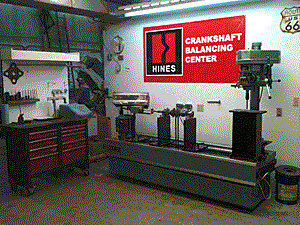
We are able to offer our customers several levels of balancing from a fairly basic rebuilders balance, High performance street, or all out racing.
Yes, we can do Cummins performance diesels along with others.
We can also do industrial balancing up to 500lbs, 3 foot diameter, and 7 foot length.
The factory balance of crankshafts can vary a great deal depending on the application and the OEM tolerances. For a low rpm stock engine, plus or minus 8 to 10 qrams or more may be close enough for the average Joe. For a street performance engine, those numbers should come down to plus or minus 3 grams or less. And for a high revving NASCAR engine that spends most of its time at 8,500 to 9,500 rpm, plus or minus 1 gram or less is the rule. How much is 1 gram? Not very much. A dollar bill weighs one gram. A penny, by comparison, weighs about 2-1/2 grams. An ordinary sheet of office paper tips the scale at a whopping 5 grams, which is more than the amount of imbalance that's generally desired in a street engine.
"Performance" This spec is for basically stock engines, or for those who want a balance job that will keep their engine from "self consumption". This is recommended for every engine, even bone stock! The dynamic tolerances are set to .7 oz. in. (19.8 grams). Connecting rods are balanced overall to within 1 gram and pistons are balanced to within 1.5 gram. Budget $275.00 for this service.
"Intermediate" This is the most used tolerance; it allows for a well balanced engine, is affordable and provides balance good enough for a sustained 6,000 RPM engine. Dynamic Balance tolerances are set to .5 oz. in. (14.2 grams) and Connecting rods are weighed end to end to within .05 gram, and pistons to within .75 gram This is the most typical state of balance. Budget $350.00 for this balance job.
"RACE" Our RACE an extreme level of balance and is good for 6500-9000 RPM engines. This is the highest state of balance we offer and we maximize the equipment with tolerances of .2 oz. in.. In this balance we take everything to the extreme, Connecting rods are balanced to .1 gram end for end, and pistons to within .1 gram. This balance takes a lot more time than any other tolerance and is not a flat rate service. Plan on spending $450.00 for this balance service.
With an internally balanced engine, you need to bring" crankshaft all rods all pistons with pins one set of piston pin locks (if used) one set of rod bearings If desired the balancer and flywheel can be balanced at the same time for an additional $75.00.
With an externally balanced engine, you need to bring" crankshaft all rods all pistons with pins one set of piston pin locks (if used) one set of rod bearings flywheel harmonic balancer
OE GM acceptable tolerance was 2.0 oz. in. (56.7 grams).
Why Balance Articles:How to Balance an Engine
Every driver has felt the effects of an out-of-balance tire. The entire car shakes and shimmies, and the steering wheel almost vibrates out of your hands. Now, just imagine what takes place inside an unbalanced engine. Instead of turning at a leisurely 600 rpm like a tire, the crank may be spinning at over 6,000 rpm. At these engine speeds, the pistons, rods, and crankshaft all become incredibly heavy; a piston whose weight is measured in ounces can exert thousands of pounds of force when it changes direction at TDC. A minor imbalance on a crankshaft counterweight is magnified many times by the centrifugal force of the spinning assembly. A single ounce of metal (28 grams) has a dynamic weight of over 700 pounds when it’s placed on a rapidly turning crankshaft counterweight. This is why balancing is a vital part of engine blueprinting.
Balancing a tire is a breeze compared to balancing an engine. A tire rotates in one plane; an engine has a crankshaft that is turning, pistons that are moving up and down, and connecting rods that are doing a little of both. This helter-skelter motion produces some very strange vibrations. The number and arrangement of the cylinders also has a tremendous impact on engine balance. A conventional V-8 engine with cylinder banks spread 90 degrees is a beautiful solution to many balancing problems. Yet if you lop off two cylinders to make a 90-degree V-6—as several automakers have recently done—you have an engine that is a disaster from the standpoint of balancing. To keep such an engine from shaking itself apart, the engineers devise all sorts of ingenious solutions, including offset crankpins, super-soft engine mounts, and special balancing techniques.
There are some engine designs that can never be perfectly balanced, no matter how much time, money, and equipment you devote to the project This is why some automobile and motorcycle manufacturers use complex counterbalancing shafts on inline fours when smoothness is an important consideration. Rearrange those four cylinders into a “V” with the proper angle between the cylinder banks, however, and the reciprocating assembly can be balanced much more easily. You don’t have to understand the detailed physics behind these effects to appreciate that some motors will always have a reputation as “shakers,” while others, with a different number or configuration of cylinders, can be silky smooth.
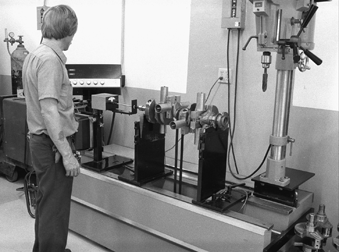
Rotating and Reciprocating Weight
For balancing purposes, the parts of the crankshaft assembly are divided into two categories: rotating weight and reciprocating weight. The crankshaft spins, so it is obviously part of the rotating mass. So are the components that spin with it, like the rod bearings. The pistons, rings, and wrist pins, on the other hand, move up and down, so they are part of the reciprocating weight. The connecting rods are a mixed case: the small end reciprocates, while the big end rotates. When an engine is balanced, all the components that are part of the reciprocating weight are matched so that none of the piston/ rod assemblies is heavier than the others. In a well-balanced engine, the weight of one piston is always offset by the weight of another piston moving in the opposite direction.
Before balancing the rotating components, a machinist must first compute the bobweight. The bobweight is the mass on a single rod journal. It takes into account the weight of the piston, pin, piston locks, rings, the reciprocating and rotating parts of the rod, and the rod bearings.
When calculating the bobweight for a conventional V-8 engine, the formula used by most machinists calls for adding 50 percent of the total reciprocating weight to the bobweight. Other engines can require a different percentage, however. The formula used to compute the bobweight for a 90-degree V-6 Chevrolet, for example, calls for adding only 46 percent of the reciprocating mass.
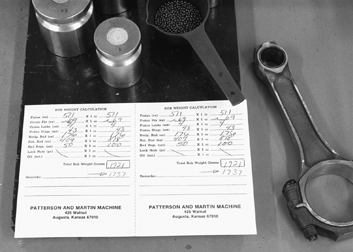
The ringer in all bobweight calculations is the weight of the oil on the components. If you dip a piston and rod assembly into a can of oil and then weigh it, the oil will add between two and ten grams to the total weight. How much oil actually clings to the rods and pistons inside a running engine—and how much it affects rotating and reciprocating weight—are difficult questions.
Some engine builders feel that the oil mist in the crankcase clings together to form a rope-like cloud that twists around the spinning crank and rotates with the assembly, which will, of course, affect the balance. Experienced engine balancers usually include an arbitrary amount of weight in the bobweight calculation to represent the oil film on the moving parts.
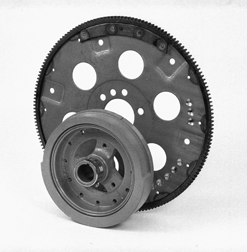
High-rpm racing engines are sometimes overbalanced. When an engine is overbalanced, the percentage of the reciprocating weight that makes up the bobweight is increased from the customary 50 percent to about 51 percent or 52 percent. Although there may be some theoretical advantages to overbalancing, the benefits are difficult to discern.
Advocates of overbalancing point out that bearing life is increased, while disbelievers maintain that the practice makes no difference in either power or reliability. Overbalancing is one of those engine-building techniques that fall into the gray category labeled “Probably Doesn’t Hurt.” For a street performance engine, using the traditional bobweight formula will provide perfectly satisfactory results.
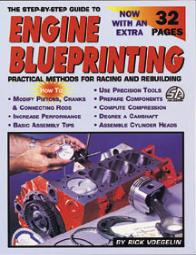
The Step-By-Step Guide to Engine Blueprinting
by Rick VoegelinPractical Methods for Racing and Rebuilding
How to buy machine shop work
Selecting and preparing parts
This completely revised and updated version containing an additional 32 pages is simply the best book you can buy on engine preparation for street or racing! Rick Voegelin's highly acclaimed combination of savvy writing and wrenching skills puts this best-seller in a class by itself. All important preparation techniques are clearly illustrated and explained in this easy-to- read text. Engine Blueprinting shows the reader how to use precision measuring tools, calculate compression ratios, degree a camshaft, and much more! Loaded with helpful advice, this book should be in every enthusiast's tool box.
"Rick Voegelin's book, The Step-by-Step Guide to Engine Blueprinting, is an excellent source of performance-oriented engine building information for the beginner and the seasoned veteran alike. This digest should be in every enthusiast's greasy mitts."
-- Steve Magnante, HOT ROD
Performance Step By Step Guide To Engine Blueprinting
Book from Amazon.ca
Engine Blueprinting, Step by Step Guide

